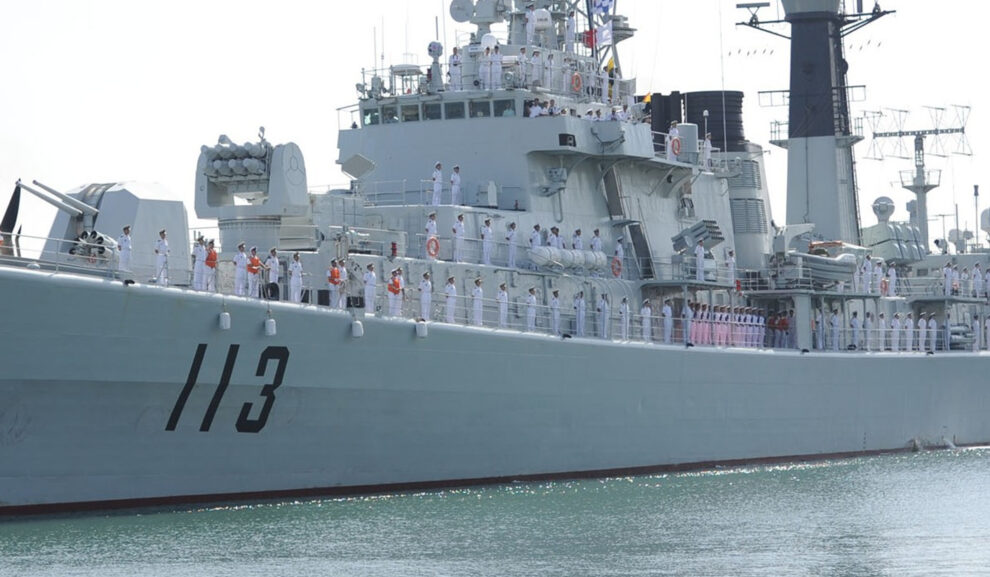Chris Bambery looks at the military, economic and political rivalries between the world’s two greatest powers, and asks whether we are looking at another hot war ahead.
The growing militarisation of the Pacific and the tensions between the US and China lead some to talk about a potential war between the states. Writing in April this year, the Financial Times’s Gideon Rachman noted:
‘Visiting Washington last week, it was striking how commonplace talk of war between the US and China has become…US officials believe that [China’s President] Xi Jinping has decided that the ‘reunification’ of mainland China and Taiwan should be the centrepiece of his legacy. They also think he is prepared to use force to secure that goal — and that he has told his military to be ready by 2027.’
While we may still be a considerable distance away from such a conflict, war games tend to show there will be no good outcome. If there was a full-scale war over Taiwan, for example, it would amount to the most damaging conflict the world has seen since 1945. The outcome of every US war game, held to predict the outcome, that I know about would be disastrous, even for the supposed victors.
The conclusions of the US Centre for Strategic and International Studies’ (CSIS) most recent intensive, simultaneous war games, as revealed to the broadcaster CNN, were that US, Japanese and Taiwanese forces could hold off a Chinese takeover of Taiwan but at huge cost:
‘The United States and Japan lose dozens of ships, hundreds of aircraft, and thousands of service members. Such losses would damage the US global position for many years,’ the report said. In most scenarios, the US Navy lost two aircraft carriers and 10 to 20 large surface combatants. Approximately 3,200 US troops would be killed in three weeks of combat, nearly half of what the US lost in two decades of combat in Iraq and Afghanistan.’
China also suffers heavily. ‘Its navy is in shambles, the core of its amphibious forces is broken, and tens of thousands of soldiers are prisoners of war.’ It estimates China would suffer about 10,000 troops killed and it would lose 155 combat aircraft and 138 major ships.
Taiwan is not unimportant economically, producing the bulk of the world’s hi-tech semiconductors. In this scenario it would be left ‘severely degraded,’ with no electricity or other basic services, and its economy would be severely damaged. Its army would suffer some 3,500 casualties, and all of its 26 destroyers and frigates would be sunk. The Japanese would lose more than 100 combat aircraft and 26 warships while US military bases on its home territory would come under attack from Chinese hypersonic missiles.
Nuclear Escalation?
Reading this, the question you might be asking is wouldn’t either side use their nuclear weapons? We have been there before. When China and Taiwan clashed militarily in 1958 the US threatened nuclear strikes on mainland China that would have left millions dead, according to classified documents revealed by Pentagon Papers whistleblower Daniel Ellsberg in 2021. In addition in November 1950, when the Chinese People’s Liberation Army joined the Korean War to stop North Korea being totally overrun, President Truman told reporters he would take whatever steps were necessary.
There is a nuclear arms race going on between the US, Russia and China and according to one report there is little chance of any agreement on limitation between them:
‘The chances for limiting nuclear arms competition through arms control agreements are zero. The U.S. recently declared that Russia is not in compliance with the recently extended New START Treaty, the last major nuclear arms treaty between the US and Russia. While Russia is embroiled in the war with Ukraine, it is unlikely that Moscow – which has suspended participation in the agreement — will ever allow inspections that would put the country in full compliance with the treaty. Meanwhile, China has been very clear that it has no interest whatsoever in an arms control regime with the US.’
The possibility of an escalation to a nuclear war is a real one, as Max Boot explained in the Washington Post:
‘The risk of nuclear escalation is all the greater because, as a senior U.S. admiral explained to me, it would be difficult for the United States to win a war over Taiwan by attacking only Chinese ships at sea and Chinese aircraft in the skies. The United States could find itself compelled, as a matter of military necessity, to attack bases in China. China, in turn, could strike U.S. bases in Japan, South Korea, the Philippines, Guam, even Hawaii and the West Coast.’ Boot points out: ‘… countries often act rashly in the heat of battle, particularly after they have suffered significant casualties and feel the need to ensure that their troops did not die in vain.’
The CSIS report also makes a very interesting comparison with Ukraine: ‘There is no “Ukraine model” for Taiwan… Once the war begins, it’s impossible to get any troops or supplies onto Taiwan, so it’s a very different situation from Ukraine where the United States and its allies have been able to send supplies continuously to Ukraine. Whatever the Taiwanese are going to fight the war with, they have to have that when the war begins.’
So, it concludes that the US should fortify its bases in Japan and Guam against Chinese missile attacks; switch its navy towards smaller and more survivable ships; prioritise submarines; prioritise sustainable bomber forces over fighter forces while producing cheaper fighters; encourage Taiwan to adopt a similar strategy, arming itself with more simple weapons platforms rather than expensive ships that are unlikely to survive a Chinese first strike.
Washington can point to successes in constructing an alliance to contain China. Japan has dramatically increased its military spending; the Aukus treaty between Australia, the UK and the US will provide Canberra with nuclear submarines capable of being armed with nuclear missiles; the US has established much closer ties with India; we have seen the strengthening of the Quad, an alliance linking America, India, Japan and Australia; the Philippines’ decision to allow the US increased military bases has helped tighten the potential blockade stopping Chinese vessels access to the Pacific and Indian Oceans.
The other side of that equation is that Beijing may feel in a similar bind to Germany in 1914, fearing it was being surrounded by the rival powers of the Entente Cordiale – France, Russia and Britain. That did not end well!
Economic capacities
What the CSIS report doesn’t say is how long either the US or China would require to rebuild, for example, its naval forces, but one war game suggests that a Chinese invasion of Taiwan would fail at a huge cost to US, Chinese and Taiwanese militaries. The Biden administration has tried to build up US naval forces. Under the 2018 National Defence Authorization Act, Congress said that the navy was required to increase the number of its combat ships to 355 (from fewer than 300 now) ‘as soon as practicable.’ But American shipbuilding capacity does not make that realisable for decades, possibly as late as the 2050s.
In the meantime the Chinese navy passed the US navy in fleet size around 2020, now has around 340 warships and is expected to grow to 400 ships.
The United States has a wider problem. On the one hand its global military dominance seems very clear. The United States commands an $858 billion budget -greater than that of the next ten countries in the world combined, the majority of whom are US allies. American military spending is about three times what China spends. The agreement Biden has reached with the Republicans over the US debt ceiling approved his increase of military spending to $886 billion in 2024, a 3.3% increase. This is beyond arms spending in the Second World War, the Korean War or at the height of the Cold War with the Soviet Union.
Last month Under Secretary of Defence, William LaPlante, gave an interview in which he explained the money was needed to rebuild and expand the nation’s domestic hypersonic missile industry. This is a key area of China’s military build-up, with US officials fearing that Beijing will use hypersonic missiles to force an American withdrawal from the Asia-Pacific region. The same point was made recently by White House National Security Adviser Jake Sullivan, who stated that the Biden administration will focus on investing in ‘cutting-edge non-nuclear capabilities,’ such as conventionally armed hypersonic missiles that can reach ‘heavily defended, high-value targets.’ These ‘high-value’ targets would be key Chinese manufacturing centres, such as shipyards, centred on its cities.
But that’s when something else comes into play: the decrease of American industrial production. To take one example, China accounts for between 45% to 50% of the world’s total shipbuilding, the US less than 1%. So if the CSIS report is anywhere near the truth and Sino-American war left the US Pacific Fleet at the bottom of the ocean, it would not be like 1941-1945 when American shipyards could massively roll out aircraft carriers, battleships, cruisers, in numbers that the enemy, Japan, could not possibly match. Now, Japan is an ally and its shipyards could help, but not on the scale of China.
Arming Ukraine has put a strain already put a strain on the US’s capacity to supply needed weaponry. On US Senate defence expert, stated, anonymously, that:
‘We haven’t fired munitions at this rate since World War II. And air defence was not something we had to worry about for 20 years in Iraq and Afghanistan, so we sort of took our eye off the ball.’ China is not under the same sort of pressure.
The US’s relative economic decline leaves it vulnerable in other ways. Components of solid rocket motors, shell casings, machine tools, fuses and precursor elements to propellants and explosives, are imported, in large part from China and India. America’s new F-35 fighter jets have a magnet component made with an alloy almost exclusively manufactured in China. China has global domination of the production of machine tools and rare earth metals, both crucial to producing munitions and missiles. The US relies on China for the lithium used in batteries, and the cobalt aluminium and titanium used in semiconductors.
Computer chip competition
But neither the US nor China produce the most advanced semiconductors so vital for building a vast range of things. Who does? Taiwan, where ‘about 60 per cent of the world’s semiconductors are made on the island, including 93 per cent of the most advanced chips. Everything that relies on a computer, from pacemakers to smartphones to artificial intelligence, depends on these wafers of metal and silicon.’
The Biden administration grasps the importance of dominance in the chips sector. Last October it published a series of strict restrictions that cut off China’s access to Western tools and workers, which are needed in the production of the most sophisticated chips. American citizens are prohibited from helping Chinese companies build chip technology above a certain level of sophistication. While global demand for semiconductors is at an all-time high, in the first four months of 2023 China saw a 25.6% fall in its imports of semiconductors, while its exports fell by 25.6% – a consequence of American sanctions impacting on Taiwanese and South Korean companies.
The United States leads in its possession of the intellectual property rights of the most developed chips, but it doesn’t produce them. The two states who do, Taiwan and South Korea, would be highly vulnerable if the current US-Chinese arms race boiled over. So, the US is keen on the new Chip 4 alliance, which seeks to unite the American chip supply chains with those of Taiwan, South Korea and Japan — to the exclusion of China.
Taiwan is the biggest producer of the most advanced semiconductors, its biggest chip maker being the Taiwan Semiconductor Manufacturing Company (TSMC). Under pressure from Washington, TSMC has agreed to open new manufacturing plants in Japan and the US. Taiwan, of course, relies on the US to protect it from any Chinese invasion, so Washington’s big club gives it big influence in Taiwan.
Truth be told, TSMC was not very keen on opening a plant in the USA, where costs are greater and there are no supporting industries. So, despite agreeing to American demands, it will concentrate semiconductor production in Taiwan. But it’s also expanded the capacity of its factory in the eastern Chinese city of Nanjing. Like many Taiwanese businesses it is reliant on trade with China.
Yet TSMC, and Taiwan, have been increasingly aligned with American policy. The company’s cooperation was indispensable to the Trump administration’s efforts to hobble Huawei, the Chinese tech giant. TSMC was a major supplier for Huawei until new US rules put an end to that. TSMC will also receive American chip subsidies linked to pledges not to further expand in China under the recently passed CHIPS and Science Act of 2022. Taiwanese officials have been receptive to a new US-proposed Chip 4 alliance, noted above. TSMC did accept the demand of the Trump administration that it break off supplying Huawei, the Chinese tech giant. Now its receiving subsidies under the terms of the 2022 US CHIPS and Science Act whereby it promised not to expand production further in China.
Some have argued that China’s reliance on Taiwanese semi-conductors can shield the island from invasion. But it would be foolish to bet on that if we look at history. Part of the rush to war in July and August 1914 concerned the desire to grab the raw materials and industries of rival powers: the coal and iron ore of Alsace Lorraine, the oil in Iraq and Persia. During the Second World War, Hitler believed the conquest of the Soviet Union would provide the Third Reich with oil and wheat.
Echoes of World War I
But in 1914, Germany was not in control of its Austro-Hungarian ally which wanted war with Serbia because it believed that country was destabilising Vienna’s rule in Bosnia, Herzegovina and Croatia. The German Kaiser would back his ally up, but could he have restrained it? Events moved quickly taking control of the situation out of his hands. That was in 1914 in the age of telegrams and steam trains, think how quickly events could change today. The assassination of the heir to the Austro-Hungarian throne by a Serbian nationalist in Sarajevo in July 1914 led to four years of bloody war across Europe and further afield.
Let’s end by pointing out that both China and the US have regional allies, often daggers drawn with one or another. India and Pakistan, for instance, are both nuclear powers and traditionally in rivalry militarily. So, both of these states are involved in an arms race, aided by their bigger backers. China provides military assistance to Pakistan and is helping to increase its stocks of nuclear missiles. In early 2022, an Indian nuclear-capable Brahmos Missile was accidentally launched into Pakistani territory. There have been deadly confrontations between Indian and Chinese troops stationed along the Line of Actual Control, the demarcation line established on the border of the two states following the 1962 Indo-Chinese war. Pakistan and India remain constantly on a war footing at the partition border of Kashmir.
The number of potential Sarajevo moments are stacking up. Matters could boil over very easily and very rapidly with terrible consequences.
Source: counterfire









